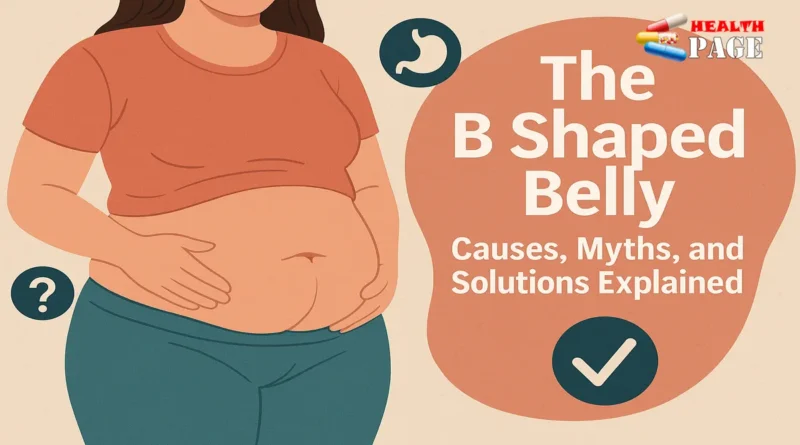The B Shaped Belly: Causes, Myths, and Solutions Explained
Have you ever noticed a horizontal crease across your midsection, creating a “B” shape? If so, you’re not alone. The B-shaped belly is a topic shrouded in myths, curiosity, and even anxiety for some. Whether you’re pregnant, postpartum, or simply navigating body changes, understanding this belly shape is key to embracing confidence and making informed health choices.
In this blog post, we’ll dive deep into what a B-shaped belly is, debunk myths, explore its causes, and share actionable tips to manage it. By the end, you’ll see why this belly shape is often a normal variation—not a health red flag. Let’s get started!
What Is a B-Shaped Belly?
A B-shaped belly is characterized by a horizontal crease or indentation that splits the abdomen into two rounded sections, resembling the letter “B.” This crease often runs across the lower or mid-abdomen, creating a distinct shape.
Key Characteristics:
- Visible horizontal line dividing the belly.
- Common during pregnancy but can occur in non-pregnant individuals.
- Not linked to weight or health status alone.
Callout Box:
“A B-shaped belly is a normal variation—your body’s unique architecture at work!”
What Causes a B-Shaped Belly? Exploring the Key Factors
1. Fascial Health and Skin Elasticity
Your fascia—the connective tissue beneath the skin—plays a role in belly shape. Hydration, stretching, and yoga can improve fascial flexibility, potentially reducing the appearance of a crease.
2. Body Size and Weight
While B-shaped bellies can occur at any size, they’re more common in individuals with higher body weights. This is due to how fat distribution and skin elasticity interact.
3. Pregnancy and Prior Pregnancies
Pregnancy stretches abdominal muscles and skin. A B-shaped belly may emerge as the uterus expands, especially in later trimesters.
4. Genetics and Muscle Structure
Some people inherit a predisposition to this shape due to muscle alignment or connective tissue patterns.
5. Conditions Like PCOS
Polycystic Ovary Syndrome (PCOS) can cause a rounded, bloated belly distinct from a B-shape. Always consult a doctor if you suspect hormonal influences.
Table: B-Shaped Belly vs. Other Belly Types
| Feature | B-Shaped Belly | PCOS Belly | Central Obesity |
|---|---|---|---|
| Shape | Horizontal crease (“B”) | Round, bloated | Protruding, “pot belly” |
| Primary Cause | Fascial/structural | Hormonal (androgens) | Excess visceral fat |
| Health Link | Usually normal | Linked to insulin resistance | Risk factor for heart disease |
B-Shaped Belly and Health: Separating Fact from Fiction
Myth: “B Bellies Mean Poor Health”
Fact: A B-shaped belly is a cosmetic trait, not a health indicator. It’s as normal as having a straight or rounded belly.
When to Be Concerned:
- Non-pregnant individuals: A sudden B-shape without weight changes could signal muscle injury or chronic stomach gripping (a habit of tensing abdominal muscles).
- Pregnancy: Always consult your doctor to rule out diastasis recti (abdominal muscle separation).
Effective Exercises and Strategies to Manage a B-Shaped Belly
1. Core Strengthening with Pilates
Pilates targets deep core muscles, improving posture and reducing the appearance of a crease.
Top Pilates Moves:
- The Hundred: Engages transverse abdominis.
- Single Leg Stretch: Enhances core stability.
2. Avoid Stomach Gripping
Chronic tensing of abs (to hide a belly) can weaken muscles and cause pain. Practice diaphragmatic breathing instead.
3. Hydration and Fascial Care
- Drink 8–10 glasses of water daily.
- Try foam rolling or gentle yoga to improve fascia elasticity.
4. Dress for Confidence
- For B-shaped bellies: High-waisted skirts, wrap dresses, and layered tops draw attention away from the crease.
FAQs About B-Shaped Bellies
Q: Can a B-shaped belly go away with exercise?
A: Yes! Core workouts like Pilates can strengthen muscles and improve posture, minimizing the crease.
Q: Is a B-shaped belly genetic?
A: Sometimes. Muscle structure and fascia elasticity can be inherited.
Q: Should I consider surgery?
A: Only consider procedures like tummy tucks if the belly causes physical discomfort (e.g., back pain) or if it’s due to excess skin after pregnancy.
Conclusion: Embrace Your Body’s Story
A B-shaped belly is rarely a cause for concern—it’s simply one of many beautiful ways our bodies are shaped. By focusing on strength, flexibility, and self-love, you can feel confident in your skin.
Call to Action:
Have you noticed a B-shaped belly? Share your journey in the comments below!



Pingback: 5 Proven Benefits of B Lines Lung Ultrasound for Early Diagnosis
Pingback: Is Pregnancy Oil Worth It? Honest Review of 6 Popular Oils